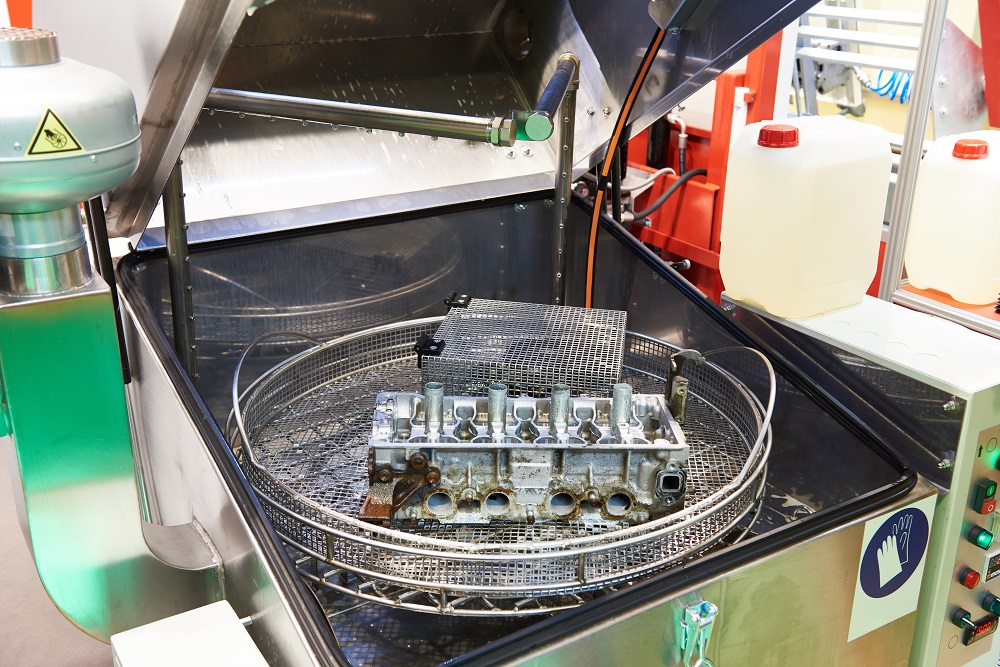Part washing is a critical stage in industrial manufacturing — it’s just as important as every other step leading up to that point. It cleans the final products of oils and other process chemicals to ensure they’re ready for end-use. If it’s not done properly, parts may be rejected by customers or spread contaminants. After all, installing parts that haven’t been fully cleaned can prevent machines from operating at maximum efficiency. Even worse, grime and oil and create costly mechanical issues that eventually ruin machines.
There are numerous cleaning processes to choose from based on part size, metal type, and industry requirements. Similar to cutting and drawing fluids, there are various part cleaning and washing compounds, each suited to specific applications and metal types.
High-Pressure Sprays
Like a dishwasher, high-pressure spray systems shoot powerful jets of heated solutions from all directions. Utilizing a mixture of water soluble cleaners or solvents, temperature control, and force, unwanted debris are quickly and efficiently removed.
This type of system is ideal for less intricate parts — but items with complex geometries may present other challenges, as the high-pressure force of the jets may not reach every crevice, leaving contaminants behind to be washed again or cleaned by hand. However, some newer generation sprays feature pressure of upwards of 10,000 psi and washer jets specifically designed to reach into difficult to clean parts features. Products like Master STAGES™ CLEAN 2115AL are ideal for this types of application.
In general, look for high-pressure spray washers that have several nozzles to reach the complete part, multiple stages such as wash, rinse, and dry, and enough power to remove heavy soils without affecting the metal they’re cleaning. Many cleaning fluids in the Master STAGES™ catalog offer superior tramp oil resistance, giving them a long sump life. Some products are suitable for use with a wide array of metals, but many are formulated for specific categories, both in terms of safety and providing effective cleaning. Some products, such as Master STAGES™ CLEAN 2017, are even formulated to remove heavy contaminants for applications like rebuild operations.
Ultrasonic Parts Cleaners
This washing method provides superior cleaning performance to all parts, even those with complex geometries. It’s the method of choice for aerospace, medical, and other precision parts industries.
Parts are submerged in a bath with an ultrasound-generating transducer. The high-frequency vibration produces microscopic “cavities” in the liquid around the parts, creating agitation that scrubs off debris and contaminants. This method removes even the toughest debris, leaving a pristine surface finish.
Look for ultrasonic cleaning solutions that have exceptional wetting ability. This will ensure parts are cleaned faster, which helps reduce cycle time. Plus, find products that rapidly split oils, bringing them to the surface during the cleaning process. These contaminants can then be skimmed or removed off the top of the cleaner bath to extend fluid life.
Pro tip: If you work with different metals, look for products that are compatible with a variety of workpieces like Master STAGES™ CLEAN 2020.
Immersion Cleaners
Immersion cleaners operate on a principle similar to ultrasonic cleaners, except the agitation is caused by moving the workpieces themselves, or the flow of the cleaning fluid. Parts are immersed in a bath on top of a reciprocating or dunk style platform. As the platform moves up and down or side to side, the drag against the cleaning solution generates friction that pulls dirt and other contaminants off the surface of the metal. This method doesn’t clean as quickly as ultrasonic machines, but it’s less expensive than the other cleaner styles, especially for larger parts and contaminants that may need to soak in the fluid to loosen the grime.
Various solutions can be used for immersion cleaning, but in general, you should look for versatile fluids designed to remove the toughest greases and oils. Highly concentrated cleaners are ideal for this, as they can be mixed at lower concentrations for reduced chemical usage.
One-Step Cleaners and Corrosion Inhibitors
Some one-step solutions that combine cleaning with rust prevention can be used in all previously mentioned cleaning methods. These fluids clean as effectively as other products but are formulated to provide short-term corrosion protection.
In general, look for water soluble, low VOC formulations that are highly concentrated — these will last the longest and have a better sustainability profile because they generate less waste. Also, use solutions that are compatible with the type of metal you’re cleaning. Remember: They’re meant to provide a corrosion protection film on the part, so they may or may not fit your specific application.
The Best Cleaning and Washing Compounds
Which cleaning and washing compound should you choose? Ultimately, it depends on the type of part you’re washing and the method you’re using. These general guidelines will help match the right solution with the right process. Consult with your suppliers for additional information about how to best wash your finished products and guidelines for cleaning fluids to use.
To learn more about how Master STAGES™ can produce cleaner parts in less time, call +1 800-537-3365 or email us at info@masterfluids.com.




